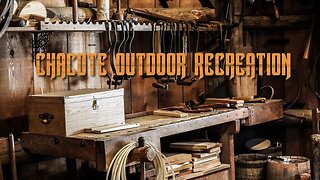Premium Only Content

Lewis H. Morgan noted that tipi frames were 13 to 15 poles that were 4.6 to 5.5 meters (15–18 ft) tall. These poles, "after being tied together at the small ends, are raised upright with a twist so as to cross the poles above the fastening. "The builders pull the lower ends out to form a circle about 3.0 metres (10 ft) in diameter on the ground. They stretch a covering of tanned and untanned buffalo hides, sewn together, over the frame, which they then secure with stakes at the base. "At the top there is an extra skin adjusted as a collar, so as to be open on the windward side to facilitate the exit of the smoke. A low opening is left for a doorway, which is covered with an extra skin used as a drop. The fire-pit and arrangements for beds are the same as in the Ojibwa lodge, grass being used in the place of spruce or hemlock twigs. Lodgepole pine is the preferred wood in the Northern and Central Plains and red cedar in the Southern Plains. Tipis have a detachable cover over the structure. The cover has historically been made of buffalo hide, an optional skin or cloth lining, and a canvas or bison calf skin door. Modern lodges are more often made of canvas.
-
 3:02
3:02
Chacote Outdoor Recreation
1 year ago $0.02 earnedLoading Stand for Muzzleloading Flintlock or Caplock Pistol Detailed Instruction.
1021 -
 LIVE
LIVE
Badlands Media
16 hours agoThe Narrative Ep. 37: The Sovereign War
16,219 watching -
 LIVE
LIVE
SpartakusLIVE
9 hours agoMega SOLO Spartan Stream - 12 hours?! HA || Variety Later?!
1,709 watching -
 LIVE
LIVE
Rallied
2 hours ago $0.08 earnedSolo Warzone Challenges All Night
1,060 watching -

Due Dissidence
11 hours agoTaibbi DEFENDS Weiss-CBS Deal, Pakman Producer SPILLS TEA, Massie CALLS OUT Trump Informant Claims
13.5K26 -
 2:33:47
2:33:47
TheSaltyCracker
4 hours agoMedia Silent on Metro Attack ReeEEStream 9-07-25
116K194 -
 56:27
56:27
Sarah Westall
5 hours agoEnd of Aging, Hydrogen Bomb Research, Serial Killers & Violent Behavior, Bipolar Research w/Dr Walsh
23.5K2 -
 4:36:53
4:36:53
MattMorseTV
6 hours ago $0.46 earned🔴Sunday Gaming🔴
49.2K2 -
 2:31:16
2:31:16
Joker Effect
3 hours agoINTERVIEWING Rumble Gaming community members: Viewbotting and how they see the current landscape.
13.1K2 -
 1:45:53
1:45:53
Nerdrotic
6 hours ago $0.27 earnedUnravelling the Secrets of Skinwalker Ranch | Forbidden Frontier #115
71.8K4